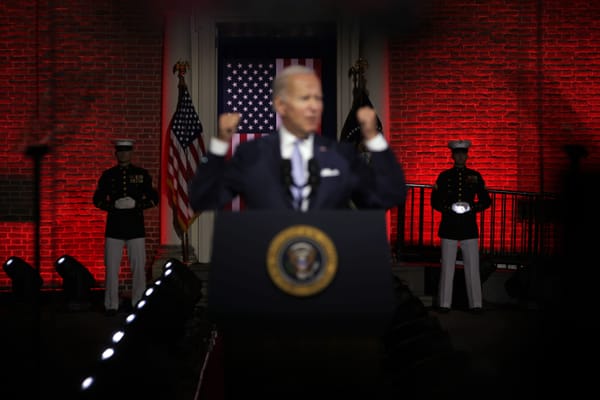The substance of President Biden’s primetime speech accusing Donald Trump and his supporters of an “extremism that threatens the very foundations of our republic” offered few real surprises: We have been hearing much the same argument from Democrats and their media allies for years. Nor, in broad strokes, were the pundit reactions all that unexpected: widespread endorsement and praise from the left and resounding repudiation from the right. Instead, what made the speech noteworthy were its eerie aesthetics.
The president stood, flanked by two stock-still armed and uniformed Marines, before Philadelphia’s Independence Hall, the hallowed structure bathed in an intense red glow amid the pitch-black night. This somber spectacle contrasted oddly with the rhetoric of the speech, in which the president positioned himself and his fellow Democrats in the “light of truth” and Republicans on the side of “darkness”: “They live in the shadow of lies,” he intoned.
For sympathetic viewers of Biden’s speech, the purpose of its foreboding backdrop was perhaps self-evident: The president’s aim was to underline the severity of the threat facing the nation and its institutions. For detractors, conversely, it was just more proof that the true threat comes from Biden and the Democrats themselves: “Yeah, [Republicans] are a threat, says the guy with the blood-red Nazi background and Marines standing behind him,” Tucker Carlson quipped.
The Biden speech comes on the heels of another controversy generated out of the Democrats’ ongoing attempt to make the midterm elections a referendum on Trump. At a fundraiser a few days earlier, the president characterized his predecessor’s governing philosophy as “semi-fascism.” Biden did not repeat the “semi-fascism” phrasing in Philadelphia, but he leaned into the same messaging—making it even odder that Biden paired his allegations with an aesthetic that at least vaguely recalled the work of Leni Riefenstahl.
The contradictions at play in the strange scene in Philadelphia go deeper than appearances. In an approving commentary on Biden’s recent rhetorical escalation, Yale philosophy professor (and noted Twitter personality) Jason Stanley states: “A fascist social and political movement revolves around a cultish leader who employs lies and propaganda to foment humiliation and fear of the ‘other.’” For Stanley, this definition vindicates Biden’s j’accuse against Trump-aligned Republicans, but it would likely sound to the latter like a description of the rhetoric of Biden’s speech, which aimed precisely at stoking “fear of the ‘other’”—i.e. the “MAGA Republican.” Ohio Senate candidate J.D. Vance stated that the president had spoken “about his fellow citizens as if they were sewer rats.”
To be sure, Biden has historically not been regarded as anything close to a “cultish leader,” which might seem to limit the relevance of Stanley’s definition here. However, his strategists have lately been aiming to change that. Last month, the White House’s Director of Digital Strategy, Rob Flaherty, tweeted out a so-called Dark Brandon meme to mark the triumph of the Inflation Reduction Act; other close advisers have done the same. “Dark Brandon” is the Democrats’ appropriation of both the insulting “Brandon” moniker derived from the “Let’s Go Brandon” chant and the “Dark MAGA” meme that spread virally among Trump supporters earlier this year.
All of this is clearly the Democrats attempting to catch up with the Trump camp’s mastery of meme warfare, using the same sort of ludic reversal that Trump supporters did, for instance, when they embraced the moniker of “deplorable.” But the promotion of the “Dark Brandon” meme from within the White House, which the Philadelphia spectacle seems to build on and extend, is also an attempt to tap into some of the aesthetic and emotional potency of the same MAGA movement Biden and other Democrats also denounce for being on the side of “darkness.”
This coincidence of escalating antagonism with imitation fits the definition of “mimetic rivalry” offered by the philosopher René Girard, who noted that often enough, the more intense a conflict becomes, the more closely the enemies come to resemble each other. Nevertheless, there is also an asymmetry between these antagonists: Only one has federal law-enforcement agencies, government bureaucracies, and the bulk of the corporate media arrayed on its side. All of this makes it unlikely the Biden camp will be forced to face up to its contradictions anytime soon.
